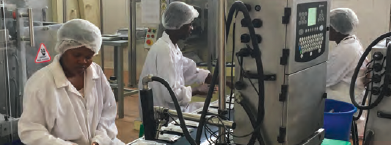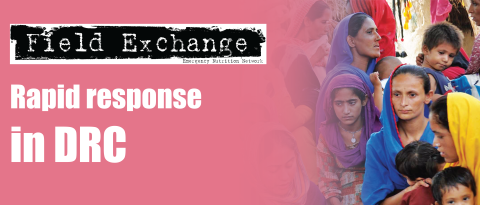Local versus offshore costs of RUTF and LNS
Summary of Research1
Segrè J, Liu G and Komrska J. (2016) Local versus offshore production of ready-to-use therapeutic foods and small quantity lipid-based nutrient supplements. Matern Child Nutr, doi: 10.1111/mcn.12376.
Location: Global
What we know: UNICEF is the largest purchaser of ready-to-use therapeutic food (RUTF) and supports local production, and has aimed to reach 50% sourcing from countries with acute malnutrition treatment programmes by 2016.
What this article adds: A recent study explored key benefits and challenges to local versus offshore manufacture of RUTF, through analyses of UNICEF procurement and the Nutriset Plumpyfield producer network. Prices and estimated costs of locally produced product have consistently been higher than offshore prices. Local manufacture faces challenges in taxation on imported ingredients, low factory utilisation, high interest rates, long cash conversion cycle and less convenient access to quality-testing labs. In a tax-free environment, local production is closer to cost parity for RUTF. Expansion of RUTF producers into the production of other ready-to-use foods (RUF) may close cost and price gaps further. Local RUF production is encouraged by a favourable tax environment, assistance in lending, consistent forecasts from buyers, investment in reliable input-supply chains and local laboratory testing.
 Ready-to-use-foods (RUF) include ready-to-use therapeutic foods (RUTF) and ready-to-use supplementary foods (RUSF), which largely refers to a range of lipid-based nutrient supplements (LNS) used in large, medium or small quantities (LQ-LNS, MQ-LNS and SQ-LNS respectively). Nutriset produces about half the global supply of RUTF (Plumpy’Nut®). Its patented formulation is shared with other manufacturers via its PlumpyField Network, which now comprises seven partners in low-income countries, and a US-based, non-profit organisation. UNICEF is the largest purchaser of RUTF and supports local production, and aimed to reach 50% sourcing from countries with acute malnutrition treatment programmes by 2016. Perceived advantages for local production include: long-term cost reduction; increased availability; economic benefits to farmers and manufacturers; and ability to customise to suit locally available ingredients, taste preferences and distribution channels.
Ready-to-use-foods (RUF) include ready-to-use therapeutic foods (RUTF) and ready-to-use supplementary foods (RUSF), which largely refers to a range of lipid-based nutrient supplements (LNS) used in large, medium or small quantities (LQ-LNS, MQ-LNS and SQ-LNS respectively). Nutriset produces about half the global supply of RUTF (Plumpy’Nut®). Its patented formulation is shared with other manufacturers via its PlumpyField Network, which now comprises seven partners in low-income countries, and a US-based, non-profit organisation. UNICEF is the largest purchaser of RUTF and supports local production, and aimed to reach 50% sourcing from countries with acute malnutrition treatment programmes by 2016. Perceived advantages for local production include: long-term cost reduction; increased availability; economic benefits to farmers and manufacturers; and ability to customise to suit locally available ingredients, taste preferences and distribution channels.
Objectives and method
This study explored the economic benefits and challenges of local RUF production through analysis of RUTF procurement and production, specifically the ~80% of the RUTF market procured by UNICEF, and the ~70% of global market produced by Nutriset and the PlumpyField network. It involved analysis of UNICEF Supply Division data, published and grey literature review, and site visits and interviews with local and offshore manufacturers.
Results
As of July 2015, UNICEF reported an RUTF supplier base of 15 manufacturers. Nine were local producers in programme countries, of which seven had local prices, two provided products both locally and for export, and two exclusively exported. The average price from offshore producers was USD$47.48 per 13.8kg carton ($42.06-$61.41/carton) versus the average local-for-local price of USD$53.21 ($46.77-$59.25); all prices are exclusive of international transport. The price gap has been narrowing since 2003.
Analysis of taxation found that UNICEF imports RUTF into high-need countries free of both import duties and value-added tax (VAT), but local producers in some countries must pay import duties for specific inputs they cannot source locally and VAT on all inputs, regardless of origin. An estimate of 2012 tax rates on standard inputs in six countries with local RUTF production showed that tax rates constitute 6-35% of total input cost. This made offshore RUTFs less expensive in some cases, after shipping, than local production.
Tax-free environments are relatively rare and the authors illustrate a cost-comparison of RUTF manufactured in Ethiopia by Hilina Enriched Foods against RUTF produced offshore by Nutriset, with and without cost of freight. Both the offshore product and imported ingredients for the local producer were exempt from import duties, making local production near parity with offshore production plus sea freight.
Across 20 suppliers in 2014, offshore manufacturers had three times the total production capacity of local manufacturers (75% of total production). In the first half of 2015, UNICEF purchased 14,714 metric tons (MT) of RUTF, with 74% from offshore manufacturers. Cost of debt was a challenge raised in interviews by local producers, with working capital in short supply and interest rates variable on borrowing capital needed to operate. Credit is more readily available to European and US producers, and banks in low-income countries typically charge higher interest rates. Local producers are more likely to have to pay for inputs in advance, wait longer for imported inputs, and must use offshore laboratory analysis and quality control facilities. An analysis of cash-conversion cycles showed a two-month difference in production time. In the most extreme case, the estimated cost of debt1 for a manufacturer in Madagascar ($30,000 per 100,000 USD of principal) is two orders of magnitude larger than the cost of debt for a manufacturer in the United States ($275 per 100,000 USD of principal).
UNICEF’s aim to reach 50% local production by 2016 was closest in 2012 with a high of 45% from manufacturers based in Africa. However, this share fell to 31% in 2014 and was at 28% in mid-2015. As far as local economic benefit, a total of 91 full-time jobs had been created in three local producers for which UNICEF had employment data. PlumpyField estimates the creation of new jobs through its network to be 500 since 2005, not including indirect employment in laboratories, agricultural supply chains and related industries.
Discussion
Challenges for local producers
Results from pricing data show that locally produced RUTF has been more expensive than offshore production to date. Price disparity, excluding shipping costs, decreased to less than 5% in 2015, but local production does not yet meet local global demand. The authors identified taxation, low factory utilisation, cost of debt and quality assurance as key challenges.
Local producers are subject to taxable, imported inputs due to lack of local availability (e.g. special milk powder) or quality standards (e.g. aflatoxin-free peanuts). Tax exemptions from both import duties and VAT would encourage cost competitiveness. Low factory utilisation may also contribute to production cost (high utilisation means lower fixed costs per unit), but spikes in demand for RUTF due to response to emergencies or variations in donor funding make this challenging for RUTF producers. Moreover, introducing large new producers may risk increasing the price for RUTF because the market is still relatively small. High-volume offshore producers are better able to aggregate demand spikes across multiple products, whereas capacity utilisation among both offshore and local suppliers to UNICEF remains low.
Other barriers for local producers are working-capital constraints, since most cannot afford to have capital tied up in product sitting in warehouses. Quality assurance poses specific challenges in local production environments. The detection of microbial contaminants in RUTF samples led to increased testing and production shortages among local manufacturers, resulting in a decrease in procurement from UNICEF programme countries in 2012-2013.
Rising costs of laboratory analysis for both inputs and finished products particularly affect local manufacturers, since samples are usually sent overseas due to a lack of certified local laboratories. One exception is Ethiopian local manufacturer, Hilina Enriched Foods, which has set up a new laboratory for local analysis that is expected to benefit RUF manufacturers across East Africa. Strict aflatoxin limits often require local RUF producers to import peanuts even when there is a domestic peanut supply. Some local producers have invested in upgrading local agricultural practices to improve their supply chain, incurring immediate costs but with potential long-term benefits.
Other potential benefits of local production
While local manufacturing creates local employment, there is little data on such indirect economic benefits to communities. As yet, products are largely not customised to local inputs, tastes and distribution channels, although there is active research and development (R&D) on new formulations with locally available or preferred ingredients that meet the same nutritional requirements. Examples include lipid-based products using lower cost, locally available inputs like chickpeas, and Vietnam’s programme using a locally developed RUTF formulation based on bean paste. Local production may help national governments integrate programmes addressing malnutrition, with local ownership potentially improving coordination in manufacturing, agricultural supply chains and health systems.
Small quantity, lipid-based nutrient supplements (SQ-LNS)
The authors suggest that expanding production of RUTF to RUSF could help local producers achieve sustainable scale, since all RUF require similar raw materials and safety standards, requiring limited further investment. SQ-LNS is composed of the same ingredients as RUTF has a larger potential market (as a preventive product) and, although it is likely subject to taxation (as a non-emergency product), would have a more predictable demand. Spikes in RUTF need could be met by adjusting volumes of SQ-LNS. Only 25-50% of the economic value of the inputs for today’s RUTF or SQ-LNS formulations is likely to be sourced in-country. Producing more SQ-LNS would likely require additional employment. Local and offshore producers for SQ-LNS may benefit from private sector partnerships with local food producers and distributors.
Conclusions
The study concludes that despite the challenges of local production, RUF should be produced by local manufacturers. In some countries, the opportunity to procure from local manufacturers can be instrumental in getting national governments to consider allocation of funding for RUTF purchase. The PlumpyField network is accelerating the transition from offshore to local production, including pooling procurement across producers to benefit from volume discounts, standardising production equipment, providing technical and quality assurance assistance, and supporting local product pilots. A number of actions are suggested to help accelerate the shift to local production of RUF:
- Governments could waive duties and VAT on inputs for RUTF;
- High-volume buyers of RUTF and SQ-LNS could consider measures to shorten cash-conversion cycles for local manufacturers;
- Buyers could make greater efforts to forecast their order volumes, enabling better matching of production capacity with order size; and
- Investment in local quality-testing facilities would reduce the length of cash-conversion cycles and testing costs.
Footnotes
1Total cost of debt was estimated using World Bank 2014 lending rates and loan duration of six months for local and one month for offshore manufacturers.
1Segrè J, Liu G and Komrska J. (2016) Local versus offshore production of ready-to-use therapeutic foods and small quantity lipid-based nutrient supplements. Matern Child Nutr, doi: 10.1111/mcn.12376.


